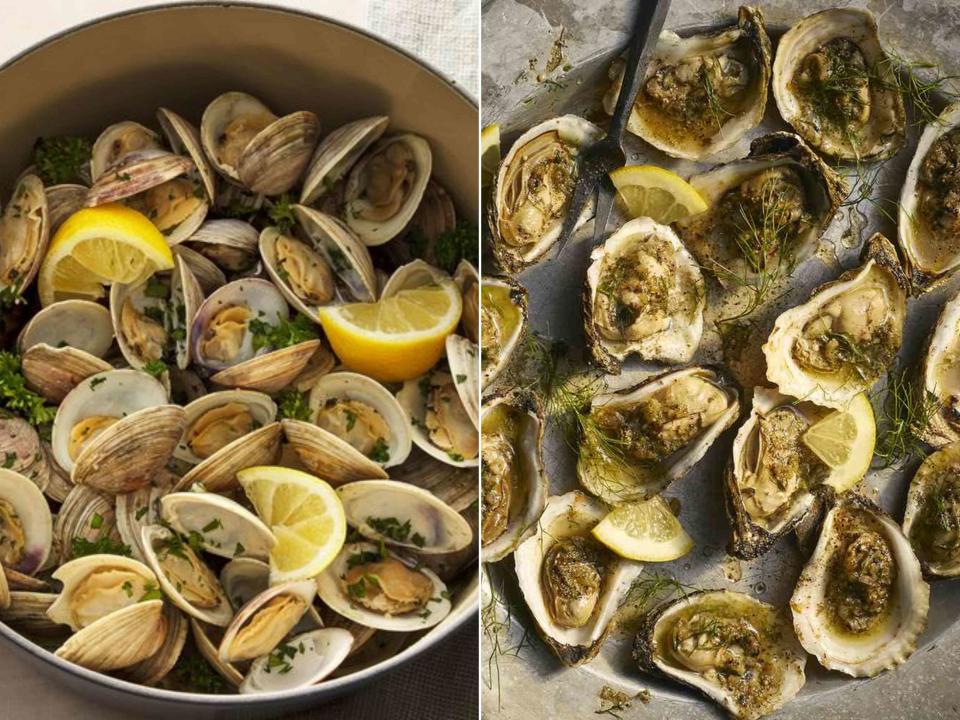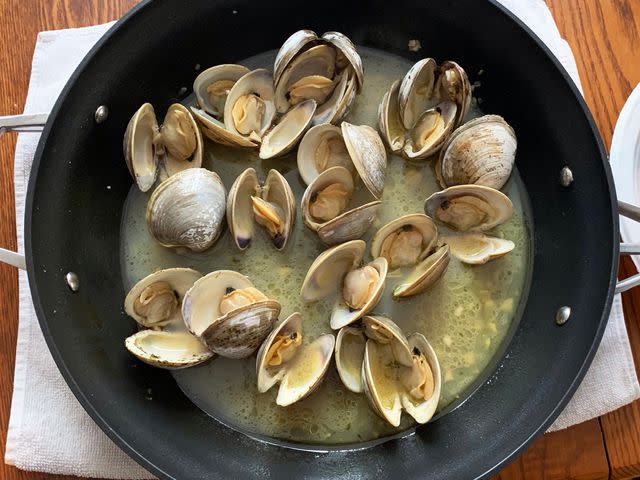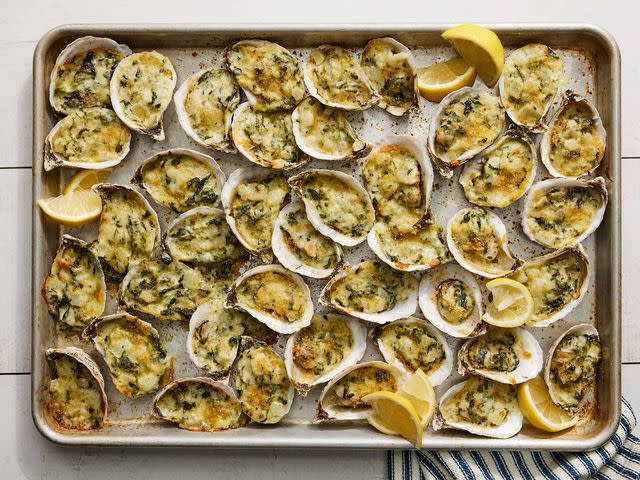Clams vs. Oysters: What's the Difference?
They're NOT the same thing.

Dotdash Meredith Food Studios
Looking at them, it's hard to believe that oysters and clams are so delicious. They’re encased in hard shells that look like rocks—and when you open them up, the shellfish inside isn’t exactly appetizing to look at.
But, if you can get past their looks, you’ll be rewarded with some of the most delicious fish the sea has to offer. Both clams and oysters have a distinctly salty, briny flavor. Different varieties have nuances and can taste very different, but overall, if you like one type of clam or oyster, you’ll also like others. Both are generally mild in flavor, making them versatile and easy to incorporate into any menu.
Clams vs. Oysters
Here are the key differences between clams and oysters:
Clams have soft, textured shells, while oysters have rough, bumpy shells.
Clamshells are more rounded, but oysters are more oval.
Clams have a mild flavor, and oysters are known for their bold, salty, briny flavor.
Oysters are most often served raw, but clams are usually served cooked.
Oysters can make pearls, but clams do not.
Clams can come from both fresh and saltwater, but oysters are saltwater-only shellfish.
What Are Clams?
Clams are bivalve mollusks with over 15,000 varieties grown in fresh and saltwater. They’re a type of shellfish, meaning the part we eat is enclosed in a very hard, inedible shell. The clam itself is soft and slightly chewy with a briny flavor.

Types of Clams
The most common types of clams for eating are soft shells (a.k.a. steamers), Atlantic hard shells, little necks, razor clams, manilas, cockles, Cherrystones, and Quahogs. Which types are available to you greatly depends on where you live; clams are a regionally specific food with different bodies of water producing different types.
Little neck and soft shell clams are great for pasta or steamed clams because of their small size and mild flavor. Hard shell and manila clams are great in chowder. Cherrystones are larger and perfect for baking and grilling. Quahogs are the largest and have the toughest meat, so they’re best for soups and stews.
How to Cook Clams
The most important step of cooking clams is cleaning them. Clams live in sand and mud and can easily bring that onto your plate. Discard any open clams, rinse in tepid water, and scrub any debris from the shells before soaking. Most clams come precleaned, but an extra half-hour soak in salted water is insurance against a mouthful of grit.
If you’re not working from a specific recipe, steaming or boiling are easy ways to showcase the clams. In both cases, you want a flavorful liquid to inject some flavor while they cook. Try seafood stock, white wine, chopped onion or garlic, herbs like parsley or tarragon, and even coconut milk.
To steam, place clams in a large pot with about an inch of your liquid, place a lid firmly on top, and cook over medium-high heat for 5 to 10 minutes, depending on the size.
To boil, fully submerge the clams in boiling water or broth for 5 to 7 minutes until they’re opened.
Like most shellfish, clams love butter, so a pat of butter just before serving elevates the flavor.
Clam Recipes
Clams are very versatile and can be incorporated into many different cuisines. There are thousands of varieties, and some are better for specific recipes than others. Try as many types as possible to find your favorites. If you’re new to cooking clams, start with some of our favorite clam recipes, and you’ll be a clam expert in no time.
What Are Oysters?
Like clams, oysters are bivalve mollusks. They are encased in a thick, bumpy shell that must be pried open before consumption. Unlike clams, oysters are often eaten raw.
Oysters only grow in saltwater and don’t like the sand or mud. They prefer rocky or pebbly environments and can attach themselves to large rocks. Oysters are often farmed rather than foraged naturally, as this is a more sustainable way to harvest them and prevent overfishing.

Types of Oysters
Varieties of oysters are generally named after where they’re grown. On the West Coast, Pacific oysters are the most common. Within the group of Pacific oysters, there are subgroups based on location. The most popular are Olympia oysters, native to Olympia, Washington. Pacific oysters can taste very different depending on where they’re grown, but they generally have a meaty, savory flavor with a punch of saltiness.
Atlantic oysters are found on the East Coast and encompass many varieties, like the Blue Points from Long Island, Wellfleets found off the coast of Cape Cod, and Cape May Salts hailing from New Jersey, to name a few. Atlantic oysters are the saltiest and have a bold, briny flavor. European flats are found in, you guessed it, Europe.
The most prized are the Bélon oysters from the Bélon river in France. European flats tend to be more mineral in flavor and are best eaten raw. Finally, there’s the Kumamoto oyster. These are highly similar to Pacific oysters and are native to Japan, but they are also grown all along the West Coast, especially in the Pacific Northwest. These are the mildest, with a very clean flavor, and are a great introduction to oysters.
How to Cook Oysters
The best way to cook oysters is not to cook them! Raw oysters are delicious, and keeping them raw preserves their nuanced and delicate flavors. To extract the oyster from the shell, you must first shuck them, essentially prying open the shell and dislodging the oyster. After shucking, you’ll be left with the bottom shell containing the oyster and its juice. From here, they can be served raw with a mignonette sauce. Store and serve them on ice to ensure they stay safe to eat raw.
If you plan to cook them, remove them from the shell and store them in the fridge for at most 24 hours, but cook them immediately for the best results.
Oyster Recipes
If you’re interested in cooked oysters, you’ve probably heard of popular dishes such as oyster Rockefeller, oyster stew, and an oyster po’boy. Oysters are great for frying, and like most seafood, love lemon and fresh herbs. Here are our must-cook oyster recipes:
Can You Substitute Clams for Oysters?
In short, no, clams and oysters are not interchangeable. While they’re both types of shellfish that look somewhat similar from the outside, they’re actually very different. Clams and oysters have distinctly different flavors and require different cooking methods. Especially when it comes to raw oysters, never substitute clams.
Read the original article on All Recipes.

